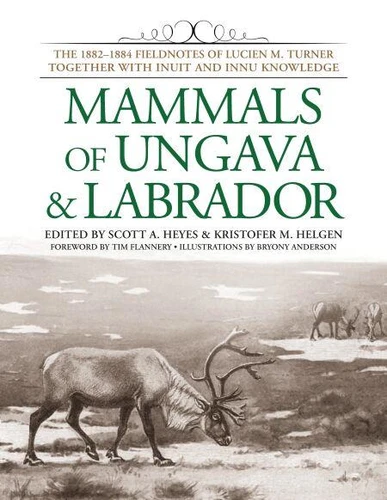Mammals of Ungava and Labrador. The 1882 - 1884 Fieldnotes of Lucien M. Turner together with Inuit and Innu Knowledge
Par : , , ,Formats :
Disponible dans votre compte client Decitre ou Furet du Nord dès validation de votre commande. Le format ePub protégé est :
- Compatible avec une lecture sur My Vivlio (smartphone, tablette, ordinateur)
- Compatible avec une lecture sur liseuses Vivlio
- Pour les liseuses autres que Vivlio, vous devez utiliser le logiciel Adobe Digital Edition. Non compatible avec la lecture sur les liseuses Kindle, Remarkable et Sony
- Non compatible avec un achat hors France métropolitaine
 , qui est-ce ?
, qui est-ce ?Notre partenaire de plateforme de lecture numérique où vous retrouverez l'ensemble de vos ebooks gratuitement
Pour en savoir plus sur nos ebooks, consultez notre aide en ligne ici
- Nombre de pages436
- FormatePub
- ISBN978-1-935623-28-1
- EAN9781935623281
- Date de parution25/02/2014
- Protection num.Adobe DRM
- Taille81 Mo
- Infos supplémentairesepub
- ÉditeurSmithsonian Institution Scholarl...
Résumé
In 1882 the Smithsonian Institution Arctic scientist, Lucien McShan Turner, traveled to the Ungava District that encompasses Northern Quebec and Labrador. There he spent 20 months as part of a mission to record meteorological data for an International Polar Year research program. While stationed at the Hudson's Bay Company Trading Post of Fort Chimo in Ungava Bay, now the Inuit community of Kuujjuaq, he soon tired of his primary task and expanded his duties to a study of the natural history and ethnography of the Aboriginal peoples of the region.
His ethnography of the Inuit and Innu people was published in 1894, but his substantial writings on natural history never made it to print. Presented here for the first time is the natural history material that Lucien M. Turner wrote on mammals of the Ungava and Labrador regions. His writings provide a glimpse of the habits and types of mammals that roamed Ungava 125 years ago in what was an unknown frontier to non-Inuit and non-Innu people.
His ethnography of the Inuit and Innu people was published in 1894, but his substantial writings on natural history never made it to print. Presented here for the first time is the natural history material that Lucien M. Turner wrote on mammals of the Ungava and Labrador regions. His writings provide a glimpse of the habits and types of mammals that roamed Ungava 125 years ago in what was an unknown frontier to non-Inuit and non-Innu people.
In 1882 the Smithsonian Institution Arctic scientist, Lucien McShan Turner, traveled to the Ungava District that encompasses Northern Quebec and Labrador. There he spent 20 months as part of a mission to record meteorological data for an International Polar Year research program. While stationed at the Hudson's Bay Company Trading Post of Fort Chimo in Ungava Bay, now the Inuit community of Kuujjuaq, he soon tired of his primary task and expanded his duties to a study of the natural history and ethnography of the Aboriginal peoples of the region.
His ethnography of the Inuit and Innu people was published in 1894, but his substantial writings on natural history never made it to print. Presented here for the first time is the natural history material that Lucien M. Turner wrote on mammals of the Ungava and Labrador regions. His writings provide a glimpse of the habits and types of mammals that roamed Ungava 125 years ago in what was an unknown frontier to non-Inuit and non-Innu people.
His ethnography of the Inuit and Innu people was published in 1894, but his substantial writings on natural history never made it to print. Presented here for the first time is the natural history material that Lucien M. Turner wrote on mammals of the Ungava and Labrador regions. His writings provide a glimpse of the habits and types of mammals that roamed Ungava 125 years ago in what was an unknown frontier to non-Inuit and non-Innu people.



